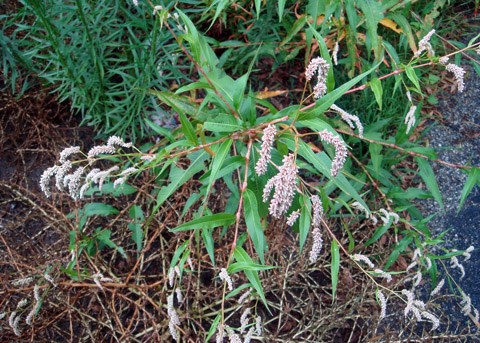Pale Smartweed Traditional Cache
-
Difficulty:
-

-
Terrain:
-

Size:  (micro)
(micro)
Please note Use of geocaching.com services is subject to the terms and conditions
in our disclaimer.
Pale Smartweed is in the knotweed family. The log is marked knotweed, as I wasn't sure of the specific name at the time.

Pale Smartweed is a plant of the family Polygonaceae. Other common names for the plant include pale smartweed, curlytop knotweed, and willow weed. It is a species complex made up of a great many varying forms, sometimes considered varieties. The environment also has a strong influence on the morphology of an individual plant.

Here is information about the plant in Illinois.
Pale Smartweed
Persicaria lapathifolia
Knotweed family (Polygonaceae)
Description: This annual plant is about 2½–4' tall, branching occasionally. The stems are light green, terete, hairless, and somewhat swollen at the petiole bases. The alternate leaves are up to 8" long and 2" across; they are medium to dark green, lanceolate, glabrous or slightly pubescent, and their margins are smooth. At the petiole bases, there are membranous sheaths (ocreae) that wrap around the stems. These sheaths often have longitudinal ribs, but they lack bristles along their upper margins. With age, the sheaths gradually turn brown and peel away. The upper stems terminate in spike-like racemes of flowers. These racemes are about 2-8" long, and they droop conspicuously downward. The small flowers are densely crowded together along the length of each raceme.

Each flower is about 1/8" (3 mm.) long, consisting of 5 tepals and the reproductive organs. These tepals are usually white or greenish white; less often they are light pink. Because the flowers don't open fully, the inner tepals can be difficult to observe. The flowers have inconspicuous pedicels (less than 1 mm. in length). The blooming period occurs from mid-summer to early fall, and lasts about 1½-2 months. There is no noticeable floral scent. The seeds are dark brown or black, ovoid and bluntly 3-angled in shape, and up to 2 mm. across. The flattened sides of the seeds are slightly concave and their surfaces are shiny. The root system is shallow and fibrous. This plant spreads by reseeding itself, often forming colonies at favorable sites.
Cultivation: The preference is full or partial sun, wet to moist conditions, and fertile soil with abundant organic matter. This plant is rather weedy, and it can be aggressive at disturbed sites. Occasional flooding is tolerated.
Range & Habitat: Pale Smartweed is a common plant that occurs in most counties of Illinois (see Distribution Map). Apparently, it has not been observed in a few counties in SW Illinois. This plant is considered native by some authorities, while others regard it as an introduction from Europe. It is possible that both North American and European ecotypes occur in Illinois. Habitats include edges of lakes and ponds, marshes, mudflats and gravel bars of rivers, prairie swales, ditches along railroads and roadsides, and moist waste areas. Occasionally, this common plant will occur at a drier site after a major disturbance, but it will decline in abundance over time. Pale Smartweed is more common in degraded wetlands than higher q
uality sites.
Faunal Associations: The floral nectar attracts Halictid bees, wasps, flies, and occasionally small butterflies. Insects that feed on the foliage and other parts of Pale Smartweed and other smartweeds (Persicaria spp.) include such leaf beetles as Chaetocnema concinna, Disonycha conjugata, Disonycha pensylvanica, Galerucella nymphaeae, Gastrophysa polygoni, and Systena frontalis (Red-Headed Flea Beetle). Other insect feeders include Capitophorus hippophaes (Polygonum Aphid) and other aphids, the larvae of Ametastegia glabrata (Dock Sawfly) and other sawflies, and the plant bug Garganus fusiformis. Among the Lepidoptera, caterpillars of the butterflies Lycaena hyllus (Bronze Copper), Lycaena helloides (Purple Copper), and Strymon melinus (Gray Hairstreak) feed on these plants; caterpillars of the last species feed on the flowers and developing seeds. The caterpillars of several species of moths also feed on smartweeds. The seeds of Pale Smartweed and other wetland smartweeds are a popular source of food to several species of ducks, sparrows, and various other birds. However, because the foliage is somewhat bitter and peppery, this species is not often eaten by mammalian herbivores. Overall, the value of this smartweed species to wildlife is high, especially to seed-eating waterfowl.

Comments: This is the largest smartweed species in Illinois. It can be distinguished from other smartweeds (Persicaria spp.) by the lack of bristles along the upper margins of its leaf sheaths (ocreae), and by its drooping cylindrical racemes with densely distributed flowers that are usually white. Other smartweeds have cylindrical racemes of flowers that are held more or less erect, or they have drooping racemes with sparsely distributed flowers. Pale Smartweed is similar in appearance to another large-sized smartweed, Pennsylvania Smartweed (Persicaria pennsylvanica) – however, this latter species has cylindrical racemes that are held more or less erect, and its flowers are often pink. Another difference between these two species is the size of their seeds: Pale Smartweed has seeds up to 2 mm. across, while Pennsylvania Smartweed has seeds that are more than 2 mm. across. Another common name for Pale Smartweed is Heart's Ease, while Polygonum lapathifolium is a scientific synonym for this species.
The cache is a tied in, camoed, "micro" pill bottle on the same side of the trail as the flowers. Rolled log with a rubber band and a plastic bag, as usual. Please BYOP and keep track of everything, so you can put it back as found. No tweezers please.
Additional Hints
(No hints available.)